Key takeaways:
- Anti-war activism emphasizes personal stories behind statistics, advocating for peace and justice.
- Effective photo storytelling captures emotional connections and contrasts the beauty of life with the destruction of war.
- Choosing subjects from war-affected communities enhances empathy and understanding in anti-war photography.
- Sharing impactful images at the right time can mobilize support and encourage meaningful conversations about conflict and peace.
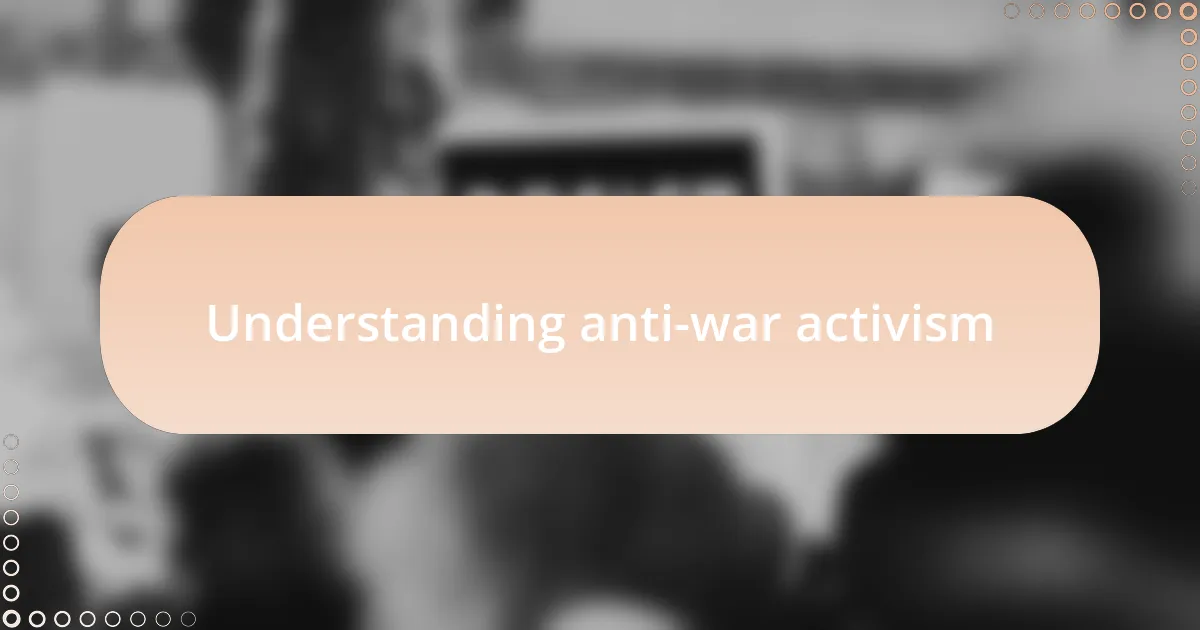
Understanding anti-war activism
Anti-war activism is deeply rooted in a desire for peace and justice, often driven by the personal experiences of those affected by conflict. I remember attending a rally where a veteran shared his story of the aftermath of war; his words resonated with many, including myself. It made me realize that behind every statistic or headline lies a human story demanding attention.
At its core, anti-war activism seeks to challenge the narrative that war is a necessary means to an end. I often find myself pondering why so many still support military action despite its devastating consequences. This questioning is crucial—it propels conversations and urges us to reconsider the impact of war on innocent lives and the environment.
Understanding anti-war activism also involves recognizing the variety of voices that contribute to this movement. For instance, during an art exhibit I visited, artists showcased powerful photography that depicted the horrors of war alongside moments of resilience. This blending of art and activism fosters a deeper connection, reminding us that the fight for peace isn’t just a political discourse; it’s a shared human experience that we all have a stake in.
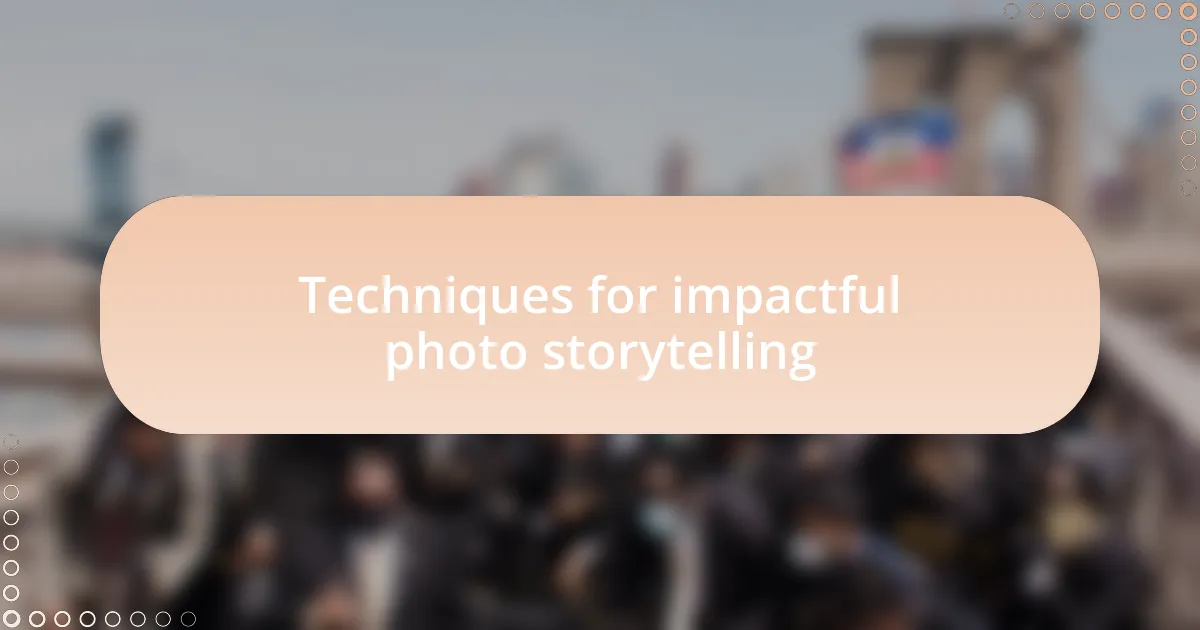
Techniques for impactful photo storytelling
One powerful technique in photo storytelling is to establish a strong emotional connection through imagery. When I captured images of protesters clashing with police in a recent demonstration, each frame told a unique story of pain and resilience. I often wonder, how does one image convey the raw emotions experienced in those moments? It’s about framing the subject in a way that resonates with the viewer, making them feel as if they are part of the scene.
Another effective approach is to incorporate elements that highlight the contrast between the beauty of life and the destruction of war. I recall photographing a vibrant community gathering set against the backdrop of a war-torn building. The juxtaposition was striking—it posed an important question: what does it mean to celebrate life amidst destruction? By capturing these contrasts, I evoke feelings of both hope and despair, inviting audiences to reflect on the harsh realities of conflict.
Lastly, a narrative arc can enhance the storytelling experience. During a project focusing on displaced families, I documented their journey from their homeland to a new life. This series not only illustrated their struggles but also their resilience and courage. I think about how essential it is for stories to evolve, allowing viewers to journey alongside the subjects. In doing so, photography can inform and inspire, urging viewers to take action as they witness the consequences of war through a personal lens.
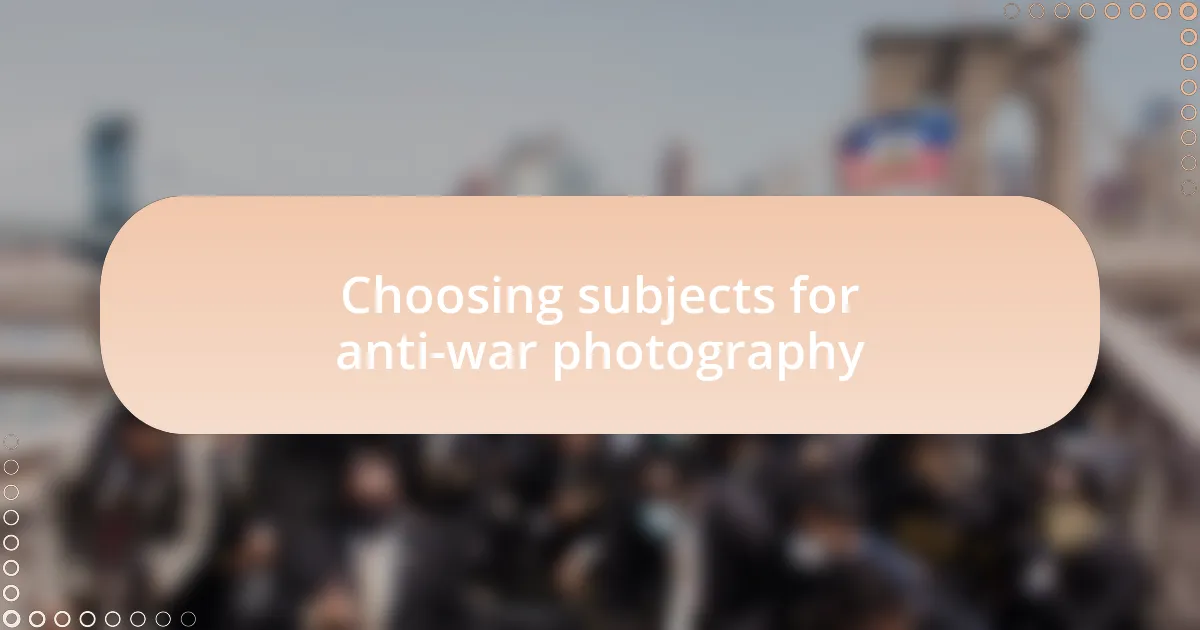
Choosing subjects for anti-war photography
Choosing subjects for anti-war photography requires a thoughtful approach. I always consider which individuals or communities are directly affected by war, as their stories resonate deeply. Once, while visiting a refugee camp, I met a young girl who shared her dreams of peace, her eyes shining with hope despite the chaos around her. I couldn’t help but think, who better to represent the impact of war than those whose lives are fundamentally altered by it?
In my experience, capturing the voices of those who are often overlooked can create powerful imagery. I remember photographing an elderly veteran sharing his perspective on conflict, his weathered hands trembling as he spoke. How often do we listen to these narratives that challenge our preconceived notions of war? By focusing on such subjects, I believe we create a richer tapestry of understanding that sparks dialogue and fosters empathy.
Moreover, I look for moments that reveal both individual and collective experiences. I once documented a community coming together to support each other after a bombing. The shared grief transformed into solidarity, and I wondered, how can such resilience inspire action? Highlighting these connections can not only amplify their stories but also inspire viewers to engage and advocate for peace.
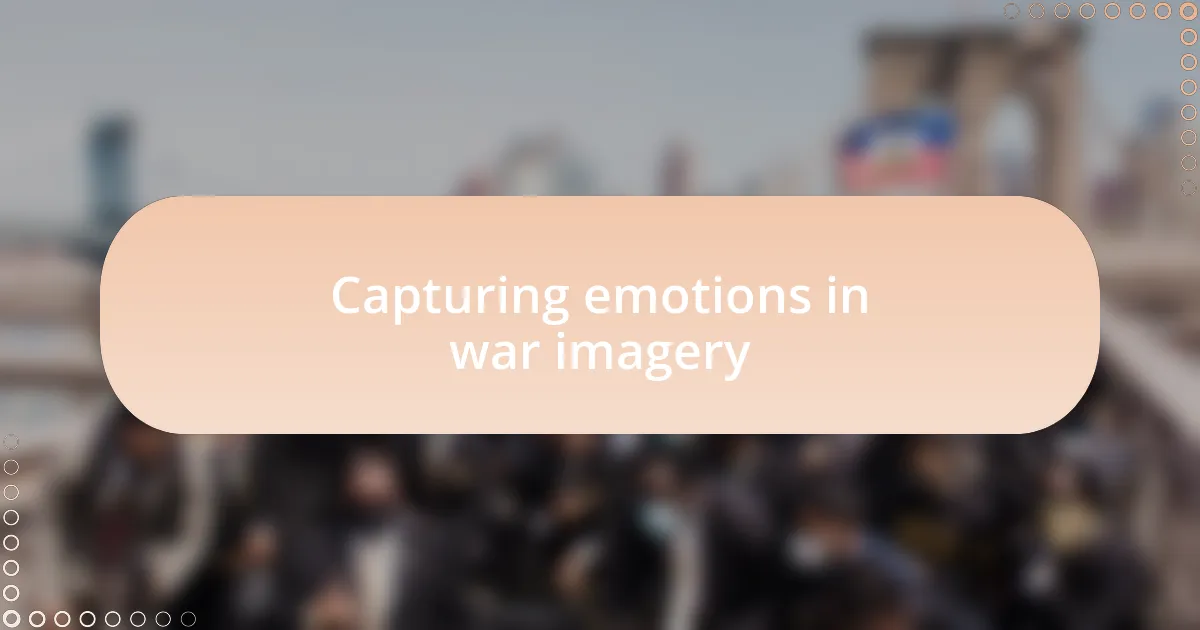
Capturing emotions in war imagery
Capturing emotions in war imagery is an intricate dance between the photographer and the subject. During one of my visits to a conflict zone, I encountered an elderly woman sitting amidst the rubble of her home, her expression a mixture of despair and resilience. How does one convey such profound sorrow while also capturing her unyielding spirit? This moment underscored for me the responsibility I have as a photographer; it’s not just about documenting suffering but also about finding the strength and humanity within those moments.
I often find that the most compelling war images are those that reveal unspoken emotions. I once photographed a group of children, their laughter clashing with the sounds of distant explosions. It struck me then, how they skillfully balanced joy and fear, seemingly untouched by the chaos that defined their landscape. Isn’t it fascinating how children can illuminate the paradoxes of war? Their innocence acts as a powerful contrast, making the viewer reflect on what is lost amid conflict.
Emotional authenticity in war imagery doesn’t just evoke sympathy; it demands action. I remember an instance where I captured a mother holding her child, both gazing towards the horizon, seemingly searching for hope. It led me to ponder, can a single image ignite the desire for change? In my experience, when emotions are raw and real, they resonate deeply with viewers, urging them to move from passive observation to active engagement in the quest for peace.

Sharing photos for maximum impact
Sharing photographs for maximum impact involves more than just the click of a shutter; it’s about the stories those images tell. I recall a time when I shared a striking image of a child displaced by conflict, their large, haunting eyes capturing the pain of loss. The comments flooded in with not just sympathy but calls for action—people wondered how they could help, which is exactly what I hoped to inspire. Why do you think certain images provoke such strong responses while others fade away?
The timing and context of sharing can also amplify a photograph’s impact. I once posted a powerful image during a major peace rally; it displayed a diverse crowd united in solidarity. The energy was palpable, and I noticed how social media gave that moment a life of its own, reaching audiences far beyond the typical activist circles. It made me realize—could the right image, at the right moment, make the difference in mobilizing support?
I believe that when we share images, we tap into a deep well of shared humanity. I remember another occasion where I paired a photo of destruction with a poignant quote from a local artist about peace. The combination sparked meaningful conversations among viewers, challenging them to rethink their perspectives on war. Isn’t it powerful to consider how an image can transcend language and culture, weaving threads of empathy that encourage understanding and unity?
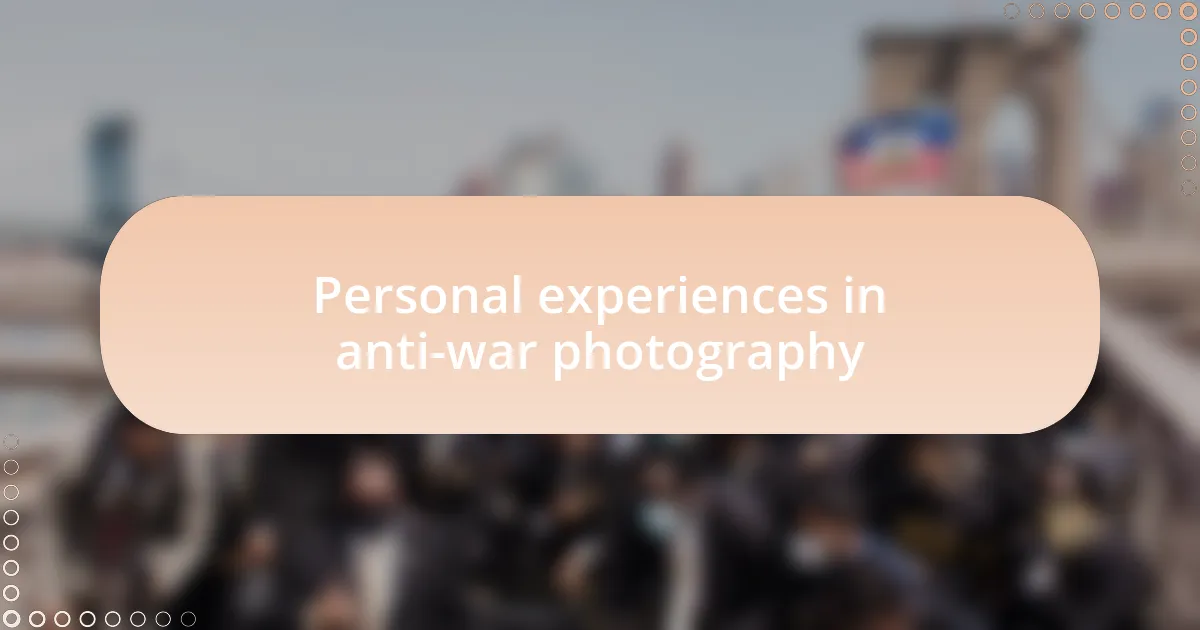
Personal experiences in anti-war photography
I remember the first time I used my camera to document a peaceful protest against war. Standing amidst the crowd, I felt the raw energy of solidarity. I captured a moment when two strangers embraced, both wearing signs of hope. Later, when I shared that image, it resonated profoundly with many, reminding me that individual connections can speak louder than words in promoting anti-war sentiments.
Another experience that stands out to me is when I visited a refugee camp and captured the daily lives of families who had fled conflict. I aimed to portray not just their struggles but also their resilience. There was one photograph of a mother cooking for her children, her expression a blend of exhaustion and determination. When viewers responded, it became clear that this image sparked conversations about compassion and responsibility. Isn’t it fascinating how a single moment can shift someone’s perspective and inspire empathy?
One particular exhibition I participated in showcased a series of black-and-white photographs highlighting the impact of war on innocent lives. Each image was accompanied by stories collected from the subjects themselves. I’m still moved by the reactions—how people were not just viewing photographs but connecting emotionally with the stories behind them. This reinforced my belief that powerful images have the potential to not only raise awareness but also ignite a desire for change. How can we harness this potential further in our activism?